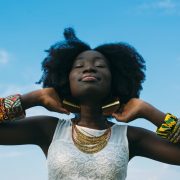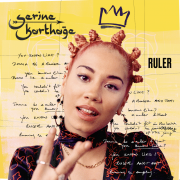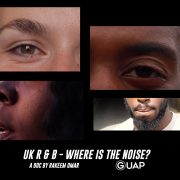The Cultural Evolution of Black Hair

Words by Tobi Ijitoye
In the late 2000s the natural hair movement started in America and spread across the globe. The movement saw black people, (mainly women) ditch the relaxers and embrace their natural curls and coils. Women shared their journeys and learnings from rediscovering their hair in its natural state through Youtube tutorials, blogs and websites. It has been almost 10 years since this pivotal moment, we are now seeing black hair in its natural state being portrayed in art, film, television, illustrations and literature.
The start of the natural hair movement saw many black women want to rediscover their natural hair, and no longer conform to beauty standard based on European standards. Black women, fed up with the lack of representation of themselves in art and illustrations has led to a number of artists creating inclusive art.
Yaga Emezi:
An Igbo-Tamil illustrator based in the US, depicts herself through little humorous character in the everyday situation we all find ourselves in. She depicts the routine of a haircare in one of her illustrations. No topic is off limit from feeling the frustratations of shaving, deciding when to masterbate and the not so secret urge to be part of Solange’s squad. She has shown it all.
https://www.instagram.com/p/BLMJO-JDjWM/?utm_source=ig_web_copy_link
Andrea Stevens:
A New York mixed media artist. Makes portraits of black women making their hair the key element of her art. The hair in her pieces are made by rolled up coloured paper to mimic the curls of afro textured hair. Andrea’s art really celebrates and showcases the beauty of afro hair.
https://www.instagram.com/p/BiUk-a7Asy7/
Kay Davies:
London based artist and textile designer creates illustrations and stickers featuring black women and girls. Her series ‘The Fruit At Home’ is of black girls with different hairstyles with fruits in their hair. Illustrating young black girls in this way, helps highlight the innocent and playfulness of black children which isn’t always portrayed. Her other works pay homage to the the tools and items black women may remember from their childhood. Looking at the images of the hair bubbles would bring back memories, of a bubble hitting you in face as you changed direction too fast whilst playing at break.
There hasn’t only been greater representation of black hair in art, there has been an increase in television, film, books too. For instance, in ABC show How to Get Away with Murder a scene where Mary J Blige’s weave being taken out at the salon shows this representation. This scene helped to further demythify black hair. The scene also brought to a wide audience the relationships that some black women form with hair salons and how it can be a space for black people to debate, share problems and just unwind in their natural state.

We have a also seen better representation in kids TV, gone are the days that characters run of a room crying because they have been ‘cursed’ with frizzy hair. Cartoons now show the variety of black hair. In Cartoon Network’s Craig of the Creek and Steven Universe, characters are now shown with traditional black hair styles. For young children watching these cartoons, this will help build their self esteem, feel included within society and not feel underrepresented. Marvel’s blockbuster hit Black Panther 2018, with its almost all black cast, the film had characters playing a wide variety of roles within the film. The film was also a visual celebration of African culture, fashion and beauty. This celebration went on to become the third highest grossing film in the US box office. Challenging the age old adage that black leads don’t sell films.
Though we are a seeing a seemly new embrace of Afro hair, this isn’t new. Emma Dabiri in her book due to be released in 2019, ‘Don’t Touch my Hair’ talks about ancient cultures the importance of hair within society. The book also touches on West African ethymologies, on how they informed practices beliefs in modern day African & Caribbean modern superstitions; such as not giving your hair cuttings to strangers. The book touches on the politics of curl type within the black community and how this relates to beauty standards. Dabiri also talks about the constant politicising of black hair in public spaces and how it is ‘not just hair’ a jibe often in response when black rise there annoyance with cultural appropriation.
As we revisit old ideas about hair and embrace the beauty of our curls, we will continue to see this reflected in art, film, television and literature. We need to continue to support these art works by sharing, buying and viewing.
@blobwithagob





![ZINO VINCI’S ‘FILTHY & DISGUSTING’EP BRINGS YOU TO THE CORE OF THE ARTIST [@ZinoVinci]](https://guap.co/wp-content/uploads/2023/10/Zino-4.jpg)





![Remel London’s [@Remel_London] “Mainstream” is a must attend for upcoming presenters!](https://guap.co/wp-content/uploads/2017/02/REMEL-LONDON-FLYER-FINAL-YELLOW-COMPLETE-1.png)